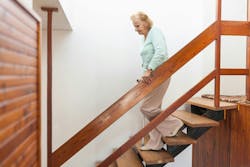Modifying homes for stroke survivors saves lives, extends independence
A clinical trial led by researchers at Washington University School of Medicine in St. Louis has found that modifications to stroke survivors’ homes – such as grab bars, shower seats, ramps and other safety interventions – reduce the risk of death within a year or so of leaving the hospital and allow many to keep living independently in their homes.
The study is available online in Archives of Physical Medicine and Rehabilitation.
The research team tested a novel program in St. Louis in which occupational therapists visited stroke survivors’ homes to identify environmental barriers – such as stairs without handrails, low toilets and dark walkways – and implement accommodations to address their specific needs. The therapists also provided self-management training that involved building problem-solving skills, such as how to connect with accessible transportation.
The clinical trial enrolled 183 individuals aged 50 and over, as they transitioned to their homes from inpatient rehabilitation facilities. They were randomly assigned to two groups: one that received at-home modifications and self-management skills, and one that received stroke education prevention during four occupational therapy sessions.
The researchers found that removing barriers and teaching problem-solving skills saved lives.
Compared with the control group, individuals in the intervention group had a higher survival rate; 10 people who received only education died over the course of the study, while no one from the intervention group died. Similarly, those who received the home modifications and self-management training were less likely to transfer to a skilled nursing facility.
Washington University School of Medicine in St. Louis release on Newswise

